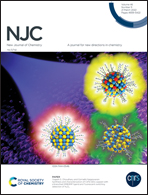Mechanism of CO2 hydrogenation over a Zr1–Cu single-atom catalyst
Abstract
The effects of Zr single atom modification on the hydrogenation mechanism of CO2 to methanol on the Cu(111) surface were investigated by density functional theory (DFT). In the HCOO pathway, 11 elementary steps were involved, which were analyzed from the aspects of kinetics and thermodynamics of each elementary reaction. bi-HCOO*, HCOOH*, H2COO*, H2COOH*, H2CO* and H3CO* are the key intermediates that are most likely to be generated. The elementary reactions of H2COO*, H2CO* and H3CO* hydrogenation have relatively high activation barriers of about 1 eV, and they are the rate-limiting steps in this pathway. The desorption barriers of HCOOH* and H2CO* are much higher than the energy barriers required for continued hydrogenation; therefore, the formation of by-products is inhibited on the Zr1–Cu single atom catalyst surface. In the COOH pathway, the hydrogenation product trans-COOH* of CO2 can further hydrogenate to t,t-COHOH* through the formation of O-H bonds; then, it facilely dissociates into COH*, and COH* continues to hydrogenate into HCOH*, H2COH* and the final product of CH3OH. The last step is the rate-limiting step, with an activation energy of 1.48 eV. In the RWGS pathway, trans-COOH* transforms to cis-COOH*, and its continued hydrogenation is more favorable than dissociation in terms of kinetics and thermodynamics. The generated HCOOH is incorporated into the HCOO pathway. The results show that the HCOO pathway is more likely to occur and has higher selectivity on Zr-modified Cu-based catalysts.



 Please wait while we load your content...
Please wait while we load your content...